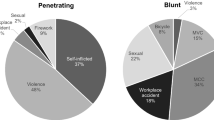Abstract
Purpose
The aim of this study was to review our 20 years of experience determining the common mechanisms of perineal trauma and initial management to evaluate the effects of classification for treatment.
Methods
A total of 75 children with perineal injuries were reviewed retrospectively, including patient demographics, mechanism of injury, associated injuries, injury severity score, presenting symptoms and methods of diagnosis and treatment.
Results
Amongst the 75 children (55 females and 20 males; mean age, 8 years), fall from height, followed by motor vehicle crash and sexual abuse were the most common reasons for injury. The most common symptom on presentation was bleeding, followed by abdominopelvic pain and tenderness. Eleven patients were allowed to heal secondarily, and 64 were examined under general anaesthesia. The affected area was repaired in 48, further diagnostic tools were needed in 20 and 11 cystoscopic, 10 rectoscopic, and 5 vaginoscopic evaluations were performed. Six patients with full-thickness injuries that extended to the peritoneum were treated with colostomy, and all were victims of motor vehicle crashes.
Conclusion
The genital injury score is a useful genital trauma scale for predicting anogenital injury severity. Identifying the mechanism and severity of perineal and associated injuries under general anaesthesia may facilitate appropriate classification and management.


Similar content being viewed by others
References
Kadish HA, Schunk JE, Britton H. Pediatric male rectal and genital trauma: accidental and non-accidental injuries. Pediatr Emerg Care. 1998;14:95–8.
Debeugny P, Bonnevalle M. Injuries of the rectum in children. 79 cases. Chir Pediatr. 1988;29:123–35.
Onen A, Oztürk H, Yayla M, Basuguy E, Gedik S. Genital trauma in children: classification and management. Urology. 2005;65(5):986–90.
Long WB, Bachulis BL, Hynes GD. Accuracy and relationship of mechanism of injury, trauma score and injury severity score in identifying major trauma. Am J Surg. 1986;151:581–4.
Noe NH, Jerkins GR. Clinical pediatric urology. In: Kelalis PP, King LR, Belman AB, editors. Genitourinary trauma in children, vol. II. 3rd ed. Philadelphia: Saunders; 1992. p. 1353–79.
Merchant W, Gibbons D, Gonzales E. Trauma to the bladder neck, trigone and vagina in children. J Urol. 1984;131:747–50.
Lynch JM, Gardner MJ, Albanese CT. Blunt urogenital trauma in prepubescent female patients: more than meets the eye! Pediatric Emerg Care. 1995;11:372–5.
Leaphart CL, Danko M, Cassidy L, Gaines B, Hackam DJ. An analysis of proctoscopy vs computed tomography scanning in the diagnosis of rectal injuries in children: which is better? J Pediatr Surg. 2006;41:700–3.
Dowd MD, Fitzmaurice L, Knapp JF, Mooney D. The interpretation of urogenital findings in children with straddle injuries. J Pediatr Surg. 1994;29:7–10.
Giardino AP, Finkel MA. Evaluating child sexual abuse. Pediatr Ann. 2005;34:382–94.
Tasian EG, Bagga HS, Fisher PB, McCulloch CE, Cinman NM, McAninch JW, et al. Pediatric genitourinary injuries in the USA from 2002 to 2010. J Urol. 2013;189:288–93.
Ivatury RR, Licata J, Gunduz Y, Rao P, Stahl WM. Management options in penetrating rectal injuries. Am Surg. 1991;57:50–5.
Ozturk H, Onen A, Dokucu AI, Otcu S, Yağmur Y, Yücesan S. Management of anorectal injuries in children: an eighteen-year experience. Eur J Pediatr Surg. 2003;13:249–55.
Levine JH, Longo WE, Pruitt C, Mazuski JE, Shapiro MJ, Durham MR. Management of selected rectal injuries by primary repair. Am J Surg. 1996;172:575–9.
Author information
Authors and Affiliations
Corresponding author
Ethics declarations
Conflict of interest
U. Bakal, M. Sarac, T. Tartar, E. B. Cigsar, and A. Kazez declare that they have no conflict of interest.
Compliance with ethical requirements
This study was conducted in accordance with the ethical requirements of the responsible committee and with the ethical principles of the 1975 Declaration of Helsinki. The study was approved by our University Clinical Ethic Committee. All participants gave their informed consent prior to their inclusion in the study.
Rights and permissions
About this article
Cite this article
Bakal, U., Sarac, M., Tartar, T. et al. Twenty years of experience with perineal injury in children. Eur J Trauma Emerg Surg 42, 599–603 (2016). https://doi.org/10.1007/s00068-015-0576-y
Received:
Accepted:
Published:
Issue Date:
DOI: https://doi.org/10.1007/s00068-015-0576-y




